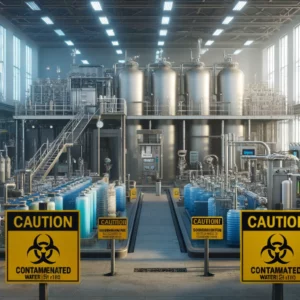What Does the New Band-Aid Lawsuit Say About Safety Concerns?
A federal class-action lawsuit filed on February 8, 2025, claims Johnson & Johnson and Kenvue sold Band-Aid products containing harmful PFAS chemicals, with OURTONE products marketed to people of color showing particularly high contamination levels. The lawsuit, filed in New Jersey federal court represents at least six customers who purchased the adhesive bandages. According to independent testing by Mamavation, 63% of bandages marketed to people with black and brown skin tones showed indications of PFAS chemicals. Both companies maintain their global headquarters in New Jersey, where the legal proceedings are now underway.
5 Key Points
- Independent testing revealed PFAS chemicals in 63% of bandages marketed to people of color.
- Three out of four Band-Aid OURTONE products target consumers with black and brown skin tones.
- The lead plaintiff claims she would not have purchased the products had she known about PFAS risks.
- Kenvue maintains Band-Aid products remain safe for consumer use.
- Both companies face allegations of knowingly concealing PFAS presence in adhesive bandages.
What Health Problems Can PFAS in Band-Aids Cause?
PFAS chemicals, used for their waterproof qualities in bandages, have triggered alerts from federal health agencies. The Centers for Disease Control and Prevention links these chemicals to cancer and immune system problems. The United States Department of Environmental Protection points to studies showing harmful effects in both humans and animals from PFAS exposure. These chemicals persist in the environment, leading to long-term exposure concerns. Consumer awareness about PFAS has expanded beyond traditional products like nonstick cookware and stain-resistant fabrics to medical supplies.
How Many Band-Aid Products for Black and Brown Skin Contain PFAS?
The lawsuit spotlights statistics about Band-Aid’s OURTONE product line. Three out of four Band-Aid products manufactured by Johnson & Johnson and Kenvue target consumers with black and brown skin tones. The Mamavation study found that 63% of bandages marketed to people with black and brown skin tones contained PFAS indicators, showing a higher rate of chemical presence in these products. This data suggests consumers with black and brown skin tones face greater exposure risks through these specifically marketed products.
Do I Qualify for the Band-Aid PFAS Lawsuit?
You may qualify to join the Band-Aid PFAS class action lawsuit if you meet these criteria:
- Purchased Band-Aid brand adhesive bandages in the United States
- Bought Band-Aid OURTONE products marketed explicitly for people of color
- Made purchases for personal or family use, not for resale
- Purchased products between 2020 and 2025
- Have proof of purchase through receipts, packaging, or purchase records
- Were unaware of PFAS presence in the products at the time of purchase
- Used the products as directed on the packaging
The lead plaintiff’s case focuses on consumers who bought these products without knowledge of potential PFAS contamination. You may still qualify without receipts based on other proof of purchase or product use.
How Do I Join the Band-Aid PFAS Lawsuit?
Consumers interested in joining the class action lawsuit can visit Lawsuits.org for more information about their legal rights and options. The litigation remains in its early stages, allowing time for new plaintiffs to join. Consumers should save their receipts and product packaging if available. The lawsuit seeks compensation for consumers who purchased these products without knowing about potential PFAS contamination.
FAQ
Q: What are PFAS chemicals?
A: PFAS are long-lasting chemicals used in Band-Aid products for waterproofing. These substances break down very slowly over time and have been linked to cancer and immune system problems by the Centers for Disease Control and Prevention.
Q: Which Band-Aid products contain PFAS?
A: According to Mamavation’s independent testing, 63% of bandages marketed to people with black and brown skin tones showed PFAS indicators. Three out of four Band-Aid OURTONE products, specifically designed for people of color, are named in the lawsuit.
Q: What health risks do PFAS in Band-Aids pose?
A: The CDC and Environmental Protection Agency link PFAS exposure to several health issues, including cancer, immune system disorders, and other adverse health effects in both humans and animals.
Q: Has Band-Aid responded to these allegations?
A: Kenvue, which manages the Band-Aid brand, released a statement to NJ Advance Media defending their products, stating, “BAND-AID® Brand Adhesive Bandages are safe, and consumers can continue to use the products as directed.”
Q: What compensation could plaintiffs receive?
A: While specific compensation amounts have not been determined, the lawsuit seeks damages for consumers who purchased Band-Aid products without knowledge of PFAS contamination. Previous Johnson & Johnson settlements have ranged from millions to billions of dollars.
Q: How long do I have to join the lawsuit?
A: The lawsuit remains in its early stages, with deadlines for joining still open. Interested consumers should visit Lawsuits.org promptly to learn about participation deadlines and requirements.
Citations
Roman, J. (2025, February 8). Band-Aids marketed to people of color contain harmful chemicals, lawsuit says. NJ.com. https://www.nj.com/healthfit/2025/02/band-aids-marketed-to-people-of-color-contain-harmful-chemicals-class-action-lawsuit-alleges.html







